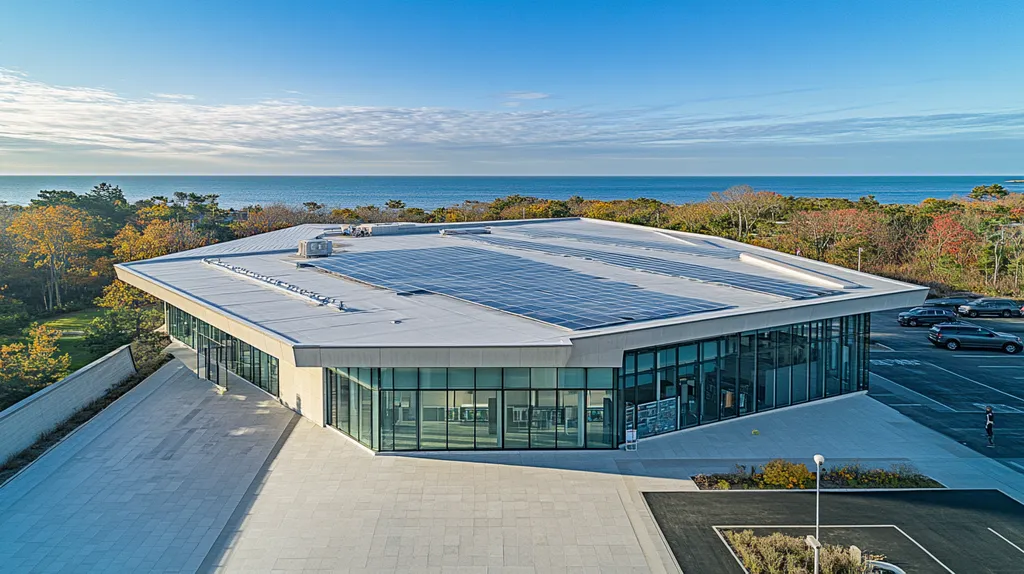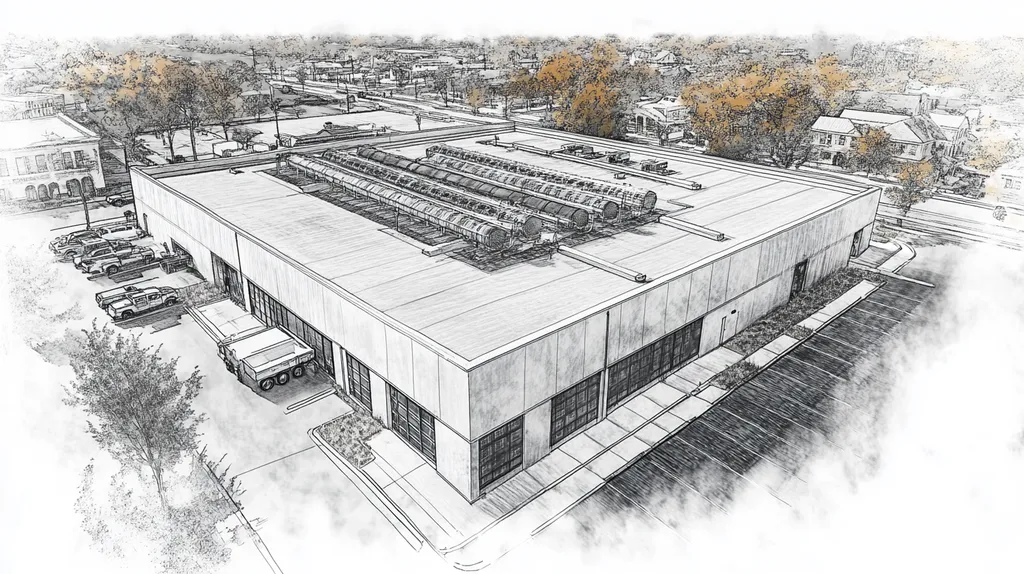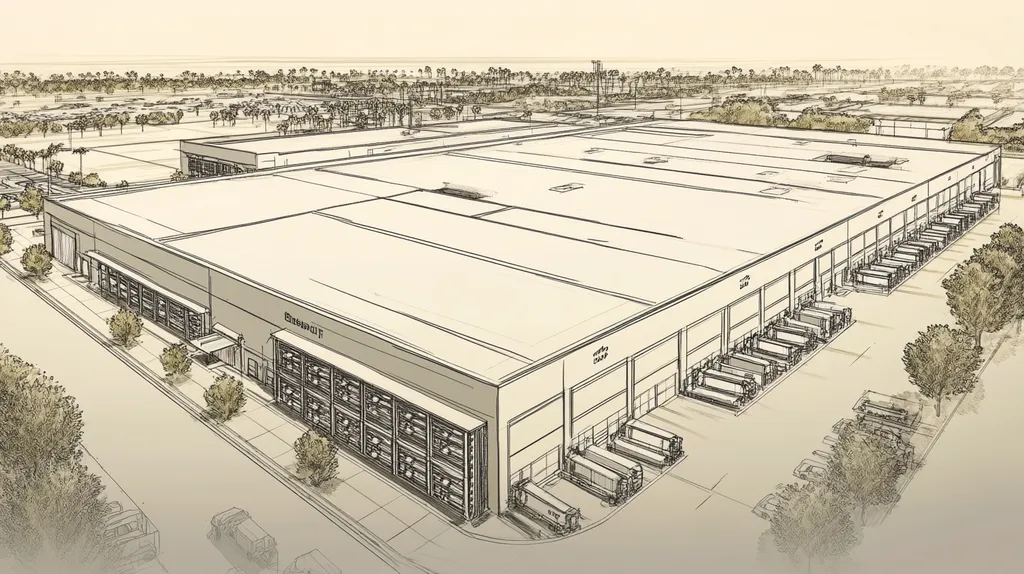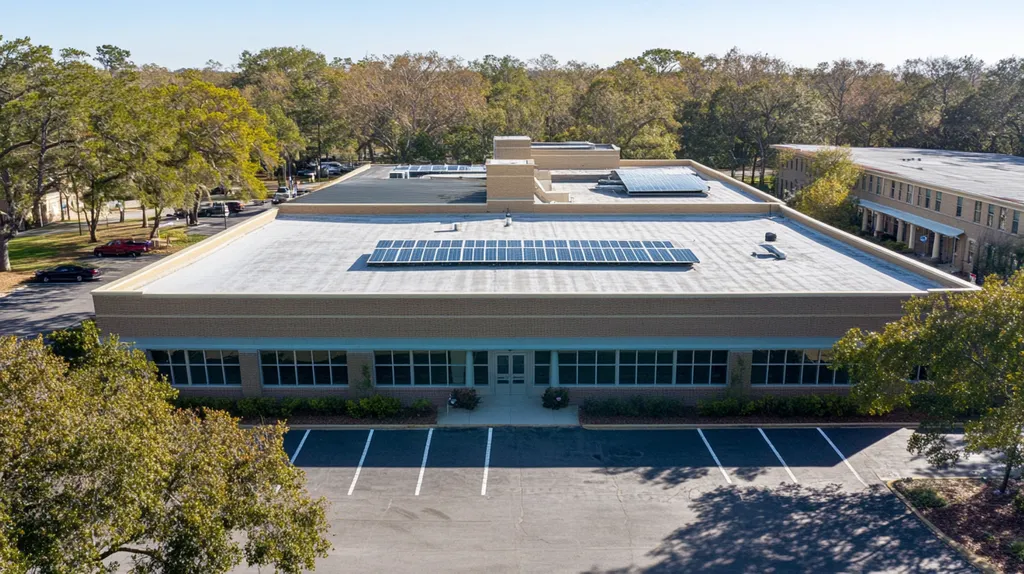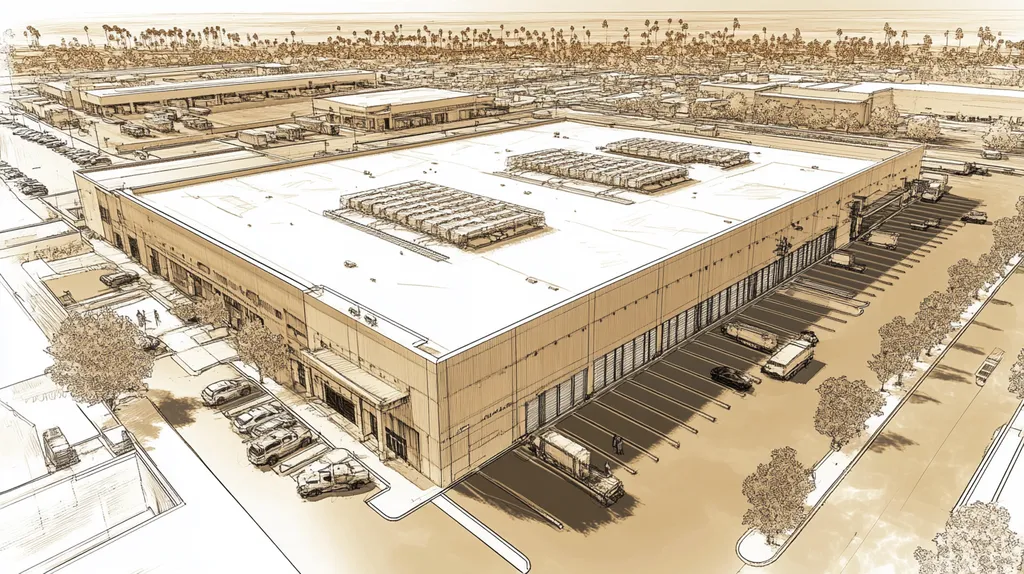In the commercial roofing industry, personal protective equipment failures contribute to over 50 workplace fatalities annually, yet established PPE practices remain dangerously inadequate.
Current safety protocols often prioritize minimal compliance over comprehensive protection, creating significant gaps in worker safety that property owners and facility managers must address.
This analysis examines how traditional PPE requirements fall short, explores systemic issues in implementation, and presents data-driven solutions to enhance rooftop safety standards across the commercial sector.
SECTION 1: CURRENT PRACTICES
Ensuring safety on commercial roofs is not just essential; it’s a matter of life and death. Falls are a significant contributor to injuries in the construction industry, responsible for nearly one-third of workplace fatalities, according to OSHA. For property owners and facility managers, understanding the existing practices surrounding personal protective equipment (PPE) for roofers is critical. This section will explore the standard PPE requirements, the challenges in enforcing compliance, and the common safety gear used in the field.
Standard PPE Requirements
The Occupational Safety and Health Administration (OSHA) outlines the standard PPE necessary for commercial roofers, including harnesses, hard hats, safety goggles, and slip-resistant boots. However, many roofing companies often view these items as the bare minimum, failing to assess the specific requirements of their workforce.
This uniform approach can create dangerous gaps in safety coverage. For instance, a roofer working with hot asphalt may need specialized heat-resistant clothing, which OSHA does not mandate. Recognizing and addressing these specific needs is vital for improving safety outcomes.
Furthermore, the fit and condition of PPE are integral to worker safety. Equipment that is ill-fitting or outdated can undermine a worker’s ability to perform tasks effectively, increasing the likelihood of accidents. Property owners should critically evaluate whether their roofing contractors adhere to, or merely comply with, these standards.
Enforcement and Compliance
The enforcement of PPE standards remains a pressing concern within the commercial roofing sector. While OSHA establishes regulations, consistent monitoring and compliance checks at job sites often fall short. Many property owners lack the resources or knowledge to ensure that contractors adhere to these guidelines.
This gap in oversight can lead to perilous working conditions. Studies have shown that roofing teams frequently operate without the necessary fall protection gear. Such negligence not only endangers workers but also places property owners at risk of legal and financial liability.
To effectively address compliance, it is imperative to foster a safety culture among all stakeholders. Initiatives like training sessions, regular audits, and mandatory safety meetings can reinforce safety protocols but often require a commitment from property managers.
Commonly Used Safety Gear
Typical safety equipment found in commercial roofing includes harnesses, helmets, safety eyewear, and gloves. Each component is designed to mitigate risks associated with specific roofing tasks. Yet, not all contractors utilize the most effective gear available in the market.
For instance, many roofers default to basic hard hats instead of opting for advanced helmets that provide superior protection against overhead impacts. In addition, standard gloves may not offer the necessary grip or cut resistance for dealing with sharp roofing materials.
Moreover, specialized equipment such as fall arrest systems and edge protection systems is often neglected in favor of standard options. This choice can significantly jeopardize worker safety, especially on steep or complex roofing structures.
By advocating for and investing in enhanced safety gear tailored to specific roofing tasks, property owners can take a proactive stance in safeguarding their workers and reducing risks associated with roofing projects.
SECTION 2: SYSTEMIC ISSUES
In the commercial roofing sector, the implications of insufficient personal protective equipment (PPE) practices are profound. According to OSHA, falls contribute to nearly one-third of fatalities in construction. This staggering figure highlights the pressing need to confront systemic issues that endanger worker safety on rooftops. Analyzing inadequate training, equipment maintenance deficiencies, and communication failures can equip property owners and facility managers with the necessary insights for fostering a safer working environment.
Inadequate Training Programs
A significant barrier to effective PPE usage in commercial roofing is the lack of comprehensive training programs. Many workers receive little to no instruction regarding the importance of protective gear, which results in inconsistent and improper usage. Research indicates that workers lacking effective training are 80% more likely to misuse their equipment.
This gap in knowledge can lead to critical errors, such as improper use of fall arrest systems, which are essential for ensuring safety on rooftops. Training programs should encompass hands-on demonstrations, regular updates, and assessments to reinforce safety protocols. Without a solid training foundation, PPE effectiveness is significantly reduced.
Additionally, training should also address the limitations of specific gear. Workers must recognize that different tasks require different types of PPE to maximize their protection. When employees have a clear understanding of this, they are more likely to use equipment correctly and minimize risks associated with their jobs.
Ultimately, insufficient training can increase accident rates and jeopardize worker safety. Commercial property owners must prioritize investment in high-quality training initiatives to mitigate these risks and protect their teams.
Equipment Maintenance Gaps
Another critical systemic issue involves gaps in equipment maintenance. Proper maintenance of PPE is vital to ensure it performs effectively when needed. Unfortunately, many companies lack regular inspection schedules, creating dangerous conditions for workers.
For instance, a failure to maintain harnesses can result in malfunction during a fall, transforming a potentially survivable incident into a fatal tragedy. OSHA mandates that all equipment undergo routine inspections, yet compliance is often overlooked. Such neglect drastically undermines the overall safety of roofing operations.
Regular maintenance not only extends the lifespan of PPE but also builds worker trust in their safety gear. When employees are assured that their protection gear is dependable, they are more likely to use it correctly. Property owners should recognize the importance of an effective maintenance schedule and invest in quality equipment.
The consequences of inadequate maintenance can be severe, leading to accidents that could have been easily averted. By addressing this issue head-on, companies can greatly enhance on-site safety and reduce the incidence of preventable injuries.
Communication Breakdowns
Communication failures within roofing teams further exacerbate the difficulties related to PPE practices. Often, workers may not fully grasp safety protocols or equipment requirements due to ambiguous messaging. For example, if supervisors do not clearly emphasize the significance of certain safety measures, workers may overlook them entirely.
This breakdown in communication fosters an environment where safety norms are inconsistently followed across teams. Regular meetings and candid discussions about safety practices are vital for cultivating a culture of accountability and awareness. When every team member understands their role in maintaining a safe workplace, compliance with PPE usage increases significantly.
Moreover, creating avenues for feedback can lead to improvements in safety protocols. Workers typically possess firsthand insights into potential hazards and can offer valuable advice on enhancing PPE practices. Involving employees in this manner promotes a sense of ownership over safety, elevating standards across the board.
Effective communication is essential for reinforcing the importance of PPE and ensuring safety practices are both understood and adhered to. By enhancing communication channels, commercial property owners can lay the groundwork for a safer work environment for their roofing teams.
SECTION 3: MISSED OPPORTUNITIES
Every year, thousands of commercial roofing workers suffer injuries that could be avoided with more effective safety practices. A large percentage of roofing accidents stem from inadequate personal protective equipment (PPE) and outdated safety protocols. It is imperative for property owners and facility managers to identify these missed opportunities in safety measures that could significantly mitigate risks. This section examines advanced safety technologies, the necessity for customized safety plans, and the critical role of worker feedback mechanisms.
Advanced Safety Technologies
Many roofing companies continue to depend on traditional PPE while overlooking innovative safety technologies now available. For example, smart helmets equipped with augmented reality provide workers with real-time environmental data, significantly enhancing their situational awareness. Organizations that adopt these technologies typically report fewer accidents and injuries.
Augmented reality systems can alert workers to nearby hazards, allowing them to make safer decisions. Additionally, drones can be used for roof inspections, enabling teams to evaluate surfaces from a safe distance. By integrating advanced safety technologies, businesses can dramatically reduce risks and better protect their workforce.
Investing in such tools improves not only safety but also operational efficiency. When employees can focus exclusively on tasks rather than constantly scanning for dangers, productivity increases. Moreover, embracing these technologies prepares companies to meet evolving safety standards and regulations.
However, many businesses hesitate to invest in innovative solutions, clinging instead to outdated practices that compromise worker safety and elevate operational costs.
Customized Safety Plans
An often-overlooked opportunity lies in the creation of customized safety plans tailored to specific roofing projects. Each roofing scenario presents unique challenges, yet many companies default to a one-size-fits-all approach, resulting in inadequate risk coverage and a higher likelihood of accidents.
Customized safety plans enable a detailed risk assessment based on the specific features of each building and roofing system. Property managers should work closely with roofing contractors to develop comprehensive plans that ensure all potential hazards are identified and managed effectively.
Specialized protocols can be tailored for various environmental conditions, project sizes, and roofing materials. This approach enhances worker safety while promoting a culture of accountability on job sites. Neglecting to implement customized plans means companies miss the chance to address unique challenges effectively.
Additionally, ongoing training for adherence to these personalized safety plans fosters a proactive safety culture. Employees are more likely to engage seriously with safety protocols when they feel their specific concerns are acknowledged.
Worker Feedback Mechanisms
Effective safety strategies must integrate worker feedback mechanisms, which are often neglected by roofing companies. This oversight can create a disconnect between management and field workers, hindering safety improvements. Encouraging open communication can illuminate gaps in current PPE practices and safety measures.
Tools like anonymous surveys and regular safety meetings allow employees to express concerns and propose enhancements. Workers on the front lines frequently provide the most insightful perspectives on potential risks and practical safety solutions.
By implementing feedback loops, organizations can tailor safety protocols based on real-world experiences. When employees see their contributions valued, they are more likely to actively participate in safety practices, leading to fewer accidents.
Ignoring worker feedback not only undermines safety improvements but may also erode trust between management and staff. A culture of safety should prioritize the insights of those directly engaged in the work.
SECTION 4: ROOT CAUSES
Addressing the root causes of inadequate PPE use in commercial roofing is critical for enhancing worker safety. Factors such as regulatory limitations, budget constraints, and a lack of industry standards significantly contribute to this persistent challenge. For instance, the Occupational Safety and Health Administration (OSHA) reveals that more than 60% of roofing injuries result from improper protective measures. Tackling these issues is essential for creating safer work environments.
Regulatory Limitations
Current regulations often fail to mandate the highest safety standards for personal protective equipment. While OSHA issues guidelines, these standards can be ambiguous, leaving room for subjective interpretation by employers. This vagueness frequently translates into inadequate safety measures on job sites.
For instance, a roofing company could provide only basic gear without enforcing its proper usage or required maintenance. Such gaps foster a culture where workers may prioritize convenience over safety.
Moreover, certain essential types of PPE, like specialized harnesses and helmets, might not be specifically mandated under existing laws. Consequently, roofers may work without crucial safety equipment, which significantly heightens their risk of accidents.
The lack of stringent regulations enables businesses to prioritize cost savings at the expense of safety, ultimately compromising the well-being of employees.
Budget Constraints
Many commercial roofing companies struggle with tight budgets that restrict their capacity to invest in high-quality personal protective equipment. Cost-cutting measures often extend to safety gear, leading to the procurement of inferior products that fail to protect workers adequately.
For example, some contractors might choose the cheapest helmets or harnesses available, compromising quality for price. Such decisions can result in equipment failures, leading to severe injuries or even fatalities.
Additionally, when bidders aim to win jobs through low quotes, they often neglect to include safety measures in their budgets. As a result, the overall safety of workers and the structural integrity of roofing projects are both jeopardized.
Although implementing comprehensive safety measures may require an initial investment, the long-term benefits, including reduced incidents and lower insurance costs, can far outweigh these upfront expenses.
Lack of Industry Standards
The absence of uniform industry standards surrounding PPE leads to considerable inconsistencies in safety practices among roofing contractors. Without established benchmarks, some employers may not prioritize safety at the same level as their competitors.
For instance, while certain companies recognize the value of high-visibility clothing and non-slip footwear, others might view them as optional. Such disparities can create dangerous work conditions that endanger employee safety.
Furthermore, the lack of industry-wide standards results in varying training and education regarding proper PPE usage. Workers may remain uninformed about the dangers associated with poor equipment choices or improper usage, resulting in preventable accidents.
Establishing clear and consistent standards could help ensure that all roofing companies adhere to a baseline level of safety, ultimately protecting workers and fostering industry credibility.
DATA DRIVEN EVIDENCE
The safety of commercial roofers is a critical concern that demands attention. In a recent year, the Bureau of Labor Statistics reported over 100 fatalities among roofers, underscoring the inherent dangers of this profession. Alarmingly, many of these accidents can be traced back to inadequate protective equipment. For property owners and facility managers, grasping the nuances of these incidents, equipment failures, and compliance inspections is essential for fostering safer roofing work environments.
Accident Statistics and Trends
Accident statistics from the roofing industry reveal stark realities about the hazards that workers face daily. In recent years, falls have accounted for nearly 40% of all roofing-related injuries. The National Safety Council highlights a consistent rise in roofing incidents, particularly during adverse weather conditions. These alarming figures signal a pressing need for property owners to reassess the effectiveness of current PPE standards.
Moreover, many of these accidents could be mitigated through enhanced training and the appropriate use of safety gear. A significant number of incidents involve workers who fail to use harnesses, even when mandated. This neglect doesn’t just threaten the safety of roofers; it also exposes property owners to increased legal and financial risks.
Identifying patterns in accident data can pinpoint specific age groups and experience levels that warrant tailored training and equipment solutions. Property owners must prioritize cultivating a safety culture that emphasizes comprehensive training alongside proper PPE.
Ultimately, there is a pressing need to transition from traditional practices to data-informed strategies. Embracing advanced safety measures can markedly reduce incidents, safeguarding both workers and the financial interests of property owners.
Equipment Failure Rates
The effectiveness of personal protective equipment (PPE) is crucial for the safety of roofing crews. Studies indicate that nearly 15% of PPE failures arise from improper maintenance or noncompliance with manufacturer guidelines. Equipment that is outdated or poorly maintained poses serious risks to workers, heightening the chance of accidents.
Furthermore, inconsistent usage of safety gear exacerbates these safety issues. Many workers opt to forgo fall protection gear due to discomfort or misconceptions about its necessity. Such choices carry catastrophic potential during standard tasks. Property owners must recognize that a commitment to high-quality PPE and ensuring its proper use is pivotal for injury prevention.
When selecting equipment, focus on impact resistance and durability should be paramount. Evidence suggests that employing modern materials and innovative designs improves compliance rates among workers. By addressing equipment failures proactively, companies can foster a safety-oriented environment.
Regular maintenance routines and equipment checks can significantly lower the likelihood of failures. This proactive approach not only safeguards workers but also aligns with industry best practices recognized by safety organizations.
Compliance Inspection Outcomes
Compliance inspections are vital for evaluating adherence to safety standards in the roofing industry. Findings often reveal that a substantial percentage of roofing operations fail to meet established PPE guidelines. Many inspection reports highlight gaps in training and inappropriate equipment use, signaling critical vulnerabilities in workforce safety.
Inspections frequently uncover a worrying trend: many roofing companies remain unaware of updated safety regulations. This knowledge gap leads to non-compliance, exposing businesses to potential legal penalties and heightened injury risks. Property owners should interpret these findings as a call to demand higher safety standards from their contractors.
Fostering a culture of regular compliance checks can significantly elevate workplace safety. When workers know inspections are routine, they are more likely to comply with safety protocols. This shift not only protects employees but also enhances the reputation of both contractors and property owners.
By prioritizing compliance and implementing best practices guided by inspection outcomes, industry stakeholders can markedly lessen the risks associated with roofing work. A steadfast commitment to safety has both short- and long-term benefits, impacting worker well-being and promoting sustainable business operations.
SECTION 6: ALTERNATIVE SOLUTIONS
The growing frequency of safety incidents in the roofing industry underscores an urgent need for innovative strategies in personal protective equipment (PPE). Traditional methods are increasingly proving inadequate, with over 30% of construction-related fatalities occurring in the roofing sector. This alarming statistic calls for a reevaluation of current safety practices. Exploring alternative solutions such as enhanced training protocols, innovative PPE designs, and integrated safety systems offers effective avenues to mitigate risks and improve safety outcomes.
Enhanced Training Protocols
Robust training protocols are essential for improving safety within the roofing industry. Current training programs often only skim the surface of PPE usage, neglecting the comprehensive safety practices that workers need. This gap in training leaves roofers unprepared for real-world risks they may encounter on the job site.
Enhanced training could incorporate simulations that replicate hazardous situations, allowing workers to effectively practice their responses. Moreover, continuous education on evolving safety technologies would keep crews up to date with best practices, fostering a culture of safety excellence.
The introduction of mentorship programs can also bridge knowledge gaps between experienced and novice workers. Pairing less experienced roofers with seasoned professionals can ensure that vital safety information is communicated and understood, leading to a collectively informed crew.
Investing in enhanced training not only equips workers with essential knowledge but also instills confidence, empowering them to prioritize safety in their daily tasks.
Innovative PPE Designs
Advancements in PPE design play a pivotal role in enhancing worker safety and comfort in commercial roofing. Traditional safety equipment often lacks significant evolution, leading to discomfort that may decrease compliance among workers. Innovative PPE designs can be developed to meet the unique challenges faced in roofing environments.
For example, harnesses designed with better ventilation and weight distribution can minimize fatigue for workers who wear them for extended periods. Incorporating lightweight and high-visibility materials enhances both comfort and visibility, encouraging more consistent use of safety gear.
Moreover, the integration of smart PPE—featuring sensors that monitor environmental conditions—can further bolster safety. This technology enables real-time data collection regarding weather changes and other risks, potentially averting accidents before they occur.
By concentrating on user-friendly and functional designs, the industry can greatly increase the likelihood of proper PPE usage among workers, thereby directly reducing injury risks.
Integrated Safety Systems
Adopting integrated safety systems can revolutionize safety management in commercial roofing projects. Current practices frequently treat safety as a collection of isolated actions. An integrated approach that combines technology, training, and equipment fosters a more comprehensive safety strategy.
Investing in aerial drones can provide real-time aerial footage of job sites, enhancing situational awareness for roofing teams. This technology allows teams to identify potential hazards from a safe distance and assists in routine inspections, reducing unnecessary risks for workers.
Additionally, wearable technology can track workers’ vital signs and fatigue levels. This integrated data can alert supervisors to potential health risks before they escalate into serious incidents, thereby enhancing overall safety.
Ultimately, integrating safety systems enables businesses to exceed mere compliance with regulations and actively protect their most valuable asset—their workforce.
Moving Forward
The data is unequivocal: commercial roofing PPE practices are failing to protect workers, with over 100 preventable fatalities occurring annually due to inadequate safety measures.
Traditional approaches to personal protective equipment have created dangerous gaps in worker safety, resulting in billions in liability costs and thousands of serious injuries industry-wide.
The integration of enhanced training protocols, innovative PPE designs, and comprehensive safety systems represents a critical opportunity to transform rooftop safety standards.
Without immediate action to address systemic failures in equipment, training, and compliance, the commercial roofing sector will continue to face increasing accident rates and mounting financial consequences.
The evidence demands a fundamental restructuring of how the industry approaches worker protection – lives and livelihoods depend on it.
FREQUENTLY ASKED QUESTIONS
Q. What are the standard PPE requirements for a commercial roof?
A. Standard PPE requirements typically include harnesses, hard hats, safety goggles, and slip-resistant boots. However, many roofing companies do not adequately assess specific worker needs, which may create gaps in safety coverage. Customizing PPE not only helps protect workers but also reduces risks associated with various roofing tasks.
Q. What systemic issues affect PPE usage on industrial roofs?
A. Systemic issues affecting PPE usage include inadequate training, equipment maintenance gaps, and communication failures. When workers lack proper training, they may misuse gear, increasing injury risks. Addressing these problems requires a concerted effort from property owners and facility managers to improve safety culture.
Q. How can property owners identify missed opportunities in roofing safety?
A. Property owners can identify missed opportunities by examining the use of advanced safety technologies, such as augmented reality tools or drones for inspections. Implementing customized safety plans tailored to specific projects can also significantly enhance safety measures while fostering worker feedback mechanisms for continuous improvement.
Q. What are the root causes of ineffective PPE in commercial roofing?
A. Root causes of ineffective PPE include regulatory limitations, budget constraints, and a lack of industry standards. These factors often lead to inadequate safety measures, increasing the risk of accidents. Addressing these root causes requires collaboration among stakeholders to enhance safety and protect workers effectively.
Q. What evidence highlights the need for improved PPE practices in commercial roofing?
A. Evidence from accident statistics shows that falls account for nearly 40% of roofing-related injuries. Many incidents involve workers neglecting the use of harnesses when needed. Compliance inspections often reveal non-adherence to safety protocols, underscoring the urgent need for improved training and equipment utilization.
Q. What alternative solutions can enhance safety for commercial roofers?
A. Alternative solutions include enhanced training protocols that incorporate real-world simulations, innovative PPE designs focused on comfort, and integrated safety systems employing technology for real-time hazard detection. These approaches can significantly mitigate risks and improve safety outcomes for roofing teams.
Q. How can facilities ensure comprehensive fall protection for commercial roofers?
A. Facilities can ensure comprehensive fall protection by investing in specialized equipment, such as edge protection systems and fall arrest devices. Conducting regular safety assessments and adopting a proactive safety culture through frequent training sessions can further enhance compliance and awareness among rooftop workers.

